Papers by Alberto Peratoner
Il parametro fondamentale nella fisiologia della termoregolazione dell'animale \ue8 la temper... more Il parametro fondamentale nella fisiologia della termoregolazione dell'animale \ue8 la temperatura corporea. Essa governa i mecanismi omeostatici che consentono un equilibrio tra produzione e dispersione del calore. Il corpo produce calore attraverso il metabolismo basale e l'esercizio fisico, ossia un lavoro, e lo scambio termico con l'ambiente avviene per convenzione, irraggiamento, conduzione ed evaporazione
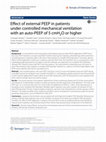
Annals of intensive care, 2016
In some patients with auto-positive end-expiratory pressure (auto-PEEP), application of PEEP lowe... more In some patients with auto-positive end-expiratory pressure (auto-PEEP), application of PEEP lower than auto-PEEP maintains a constant total PEEP, therefore reducing the inspiratory threshold load without detrimental cardiovascular or respiratory effects. We refer to these patients as "complete PEEP-absorbers." Conversely, adverse effects of PEEP application could occur in patients with auto-PEEP when the total PEEP rises as a consequence. From a pathophysiological perspective, all subjects with flow limitation are expected to be "complete PEEP-absorbers," whereas PEEP should increase total PEEP in all other patients. This study aimed to empirically assess the extent to which flow limitation alone explains a "complete PEEP-absorber" behavior (i.e., absence of further hyperinflation with PEEP), and to identify other factors associated with it. One hundred patients with auto-PEEP of at least 5 cmH2O at zero end-expiratory pressure (ZEEP) during controlled...
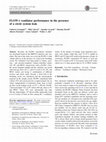
Journal of Clinical Monitoring and Computing, 2016
Recently, the FLOW-i anaesthesia ventilator was developed based on the SERVO-i intensive care ven... more Recently, the FLOW-i anaesthesia ventilator was developed based on the SERVO-i intensive care ventilator. The aim of this study was to test the FLOW-i's tidal volume delivery in the presence of a leak in the breathing circuit. We ventilated a test lung model in volume-, pressure-, and pressure-regulated volume-controlled modes (VC, PC, and PRVC, respectively) with a FLOW-i. First, the circuit remained airtight and the ventilator was tested with fresh gas flows of 6, 1, and 0.3 L/min in VC, PC, and PRVC modes and facing 4 combinations of different resistive and elastic loads. Second, a fixed leak in the breathing circuit was introduced and the measurements repeated. In the airtight system, FLOW-i maintained tidal volume (VT) and circuit pressure at approximately the set values, independently of respiratory mode, load, or fresh gas flow. In the leaking circuit, set VT = 500 mL, FLOWi delivered higher VTs in PC (about 460 mL) than in VC and PRVC, where VTs were substantially less than 500 mL. Interestingly, VT did not differ appreciably from 6 to 0.3 L/min of fresh air flow among the 3 ventilatory modes. In the absence of leakage, peak inspiratory pressures were similar, while they were 35-45 % smaller in PRVC and VC than in PC mode in the presence of leaks. In conclusion, FLOW-i maintained VT (down to fresh gas flows of 0.3 L/min) to 90 % of its preset value in PC mode, which was 4-5 times greater than in VC or PRVC modes.

Neurology, Jan 10, 2016
To identify reliable predictors of outcome in comatose patients after cardiac arrest using a sing... more To identify reliable predictors of outcome in comatose patients after cardiac arrest using a single routine EEG and standardized interpretation according to the terminology proposed by the American Clinical Neurophysiology Society. In this cohort study, 4 EEG specialists, blinded to outcome, evaluated prospectively recorded EEGs in the Target Temperature Management trial (TTM trial) that randomized patients to 33°C vs 36°C. Routine EEG was performed in patients still comatose after rewarming. EEGs were classified into highly malignant (suppression, suppression with periodic discharges, burst-suppression), malignant (periodic or rhythmic patterns, pathological or nonreactive background), and benign EEG (absence of malignant features). Poor outcome was defined as best Cerebral Performance Category score 3-5 until 180 days. Eight TTM sites randomized 202 patients. EEGs were recorded in 103 patients at a median 77 hours after cardiac arrest; 37% had a highly malignant EEG and all had a ...

Scandinavian Journal of Trauma, Resuscitation and Emergency Medicine, 2015
Background: There is substantial variation in the incidence, likelihood of attempted resuscitatio... more Background: There is substantial variation in the incidence, likelihood of attempted resuscitation and outcomes from out-of-hospital cardiac arrest (OHCA) across Europe. A European, multi-centre study provides the opportunity to uncover differences throughout Europe and may help find explanations for these differences. Results may also have potential to support the development of quality benchmarking between European Emergency Medical Services (EMS). Methods/Design: This prospective European study involves 27 different countries. It provides a common Utstein-based dataset, data collection tool and a common data collection period for all participants. Study research questions will address the following: OHCA incidence in different European regions; incidence of cardiopulmonary resuscitation (CPR); initial presenting rhythm in patients where bystanders or EMS start CPR or any other resuscitation intervention; proportion of patients with any return of spontaneous circulation (ROSC); patient status at the end of pre-hospital treatment i.e. ROSC at handover to hospital, ongoing CPR, dead; proportion of patients still alive 30 days after OHCA; proportion of patients discharged alive from hospital. All patients who suffered an OHCA during October 2014 and were attended and/or treated by an EMS and documented in one of the participating registries will be included in the study. Each National Coordinator is responsible for data collection and quality control in his/her country and will transfer unprocessed anonymised data via secure electronic transfer. Descriptive analysis will be performed at European, national and registry level. For endpoints like ROSC, admission or survival, multivariate logistic regression analysis will be performed. Discussion: Documenting differences in epidemiology, treatment and outcome in out-of-hospital cardiac arrest throughout Europe is a first step in finding explanations for these differences. Study results might also support the development of quality benchmarking between Emergency Medical Services (EMS) which in turn will facilitate initiatives to improve OHCA outcome in Europe. Trial registration: The EuReCa ONE Study is registered by ClinicalTrials.gov National CoordinatorT02236819).
Perioperative and Critical Care Medicine
Mechanical ventilation represents the most widely used supportive technique in the intensive care... more Mechanical ventilation represents the most widely used supportive technique in the intensive care unit (ICU). Without mechanical support for respiration, many patients would die within a few hours due to acute hypoxaemic and hypercapnic respiratory failure. Several forms of external support for respiration have been described in the literature to assist the failing ventilatory system. Chief among these is endotracheal

Respiratory Physiology & Neurobiology, 2006
High-frequency percussive ventilation (HFPV) has been proved useful in patients with acute respir... more High-frequency percussive ventilation (HFPV) has been proved useful in patients with acute respiratory distress syndrome. However, its physiological mechanisms are still poorly understood. The aim of this work is to evaluate the effects of mechanical loading on the tidal volume and lung washout during HFPV. For this purpose a single-compartment mechanical lung simulator, which allows the combination of three elastic and four resistive loads (E and R, respectively), underwent HFPV with constant ventilator settings. With increasing E and decreasing R the tidal volume/cumulative oscillated gas volume ratio fell, while the duration of end-inspiratory plateau/inspiratory time increased. Indeed, an inverse linear relationship was found between these two ratios. Peak and mean pressure in the model decreased linearly with increasing pulsatile volume, the latter to a lesser extent. In conclusion, elastic or resistive loading modulates the mechanical characteristics of the HFPV device but in such a way that washout volume and time allowed for diffusive ventilation vary agonistically.

Respiratory Physiology & Neurobiology, 2004
High-frequency percussive ventilation (HFPV) has proved its unique efficacy in the treatment of a... more High-frequency percussive ventilation (HFPV) has proved its unique efficacy in the treatment of acute respiratory distress, when conventional mechanical ventilation (CMV) has demonstrated a limited response. We analysed flow (V dot), volume (V) and airway pressure (P aw) during ventilation of a singlecompartment mechanical lung simulator, in which resistance (R) and elastance (E) values were modified, while maintaining the selected ventilatory settings of the HFPV device. These signals reveal the physical effect of the imposed loads on the output of the ventilatory device, secondary to constant (millisecond by millisecond) alterations in pulmonary dynamics. V dot , V and P aw values depended fundamentally on the value of R, but their shapes were modified by R and E. Although peak P aw increased 70.3% in relation to control value, mean P aw augmented solely 36.5% under the same circumstances (maximum of 9.4 CmH 2 O). Finally, a mechanism for washing gas out of the lung was suggested.
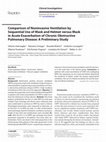
Respiration, 2011
Background:Noninvasive positive pressure ventilation (NPPV) using a face mask is the ventilatory ... more Background:Noninvasive positive pressure ventilation (NPPV) using a face mask is the ventilatory mode of choice in selected patients experiencing acute exacerbation of chronic obstructive pulmonary disease (COPD). A high incidence of intolerance limits the use of this approach. Objective: To evaluate the sequential use of mask and helmet during NPPV in patients with severe exacerbation of COPD in order to reduce the intolerance to these devices. Methods: Fifty-three patients ventilated for the first 2 h with NPPV by mask were studied. If gas exchange and clinical status improved, they were randomized to continue on NPPV by mask or helmet.Physiological parameters were measured at admission, after the first 2 h on NPPV by mask, 4 h after randomization and at discharge. Need for intubation, ventilatory assistance, length of stay (LOS) and complications were recorded. Results: After the first 2 h of NPPV, gas exchange and clinical parameters improved in 40 patients. Four hours after ran...
European Respiratory Journal, 2000
Bedside assessment of respiratory viscoelastic properties in ventilated patients. V.
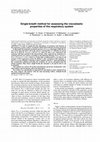
European Respiratory Journal, 1998
In order to explain the time dependency of resistance and elastance of the respiratory system, a ... more In order to explain the time dependency of resistance and elastance of the respiratory system, a linear viscoelastic model (Maxwell body) has been proposed. In this model the maximal viscoelastic pressure (Pvisc.max) developed within the tissues of the lung and chest wall at the end of a constant-flow (V') inflation of a given time (tI) is given by: Pvisc,max = R2V'(1-e(-tI/tau2), where R2 and tau2 are, respectively, the resistance and time constant of the Maxwell body. After rapid airway occlusion at t1, tracheal pressure (Ptr) decays according to the following function: Ptr(t) = Pvisc(t) + Prs,st = Pvisc,max(etocc/tau2)+ Prs,st, where tocc/is time after occlusion and Prs,st is static re-coil pressure of the respiratory system. By fitting Ptr after occlusion to this equation, tau2 and Pvisc,max are obtained. Using these values, together with the V' and tI pertaining to the constant-flow inflation preceding the occlusion, R2 can be calculated from the former equation. Th...
European Journal of Anaesthesiology, 2000
European Journal of Anaesthesiology, 2000
European Journal of Anaesthesiology, 2000
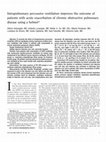
Critical Care Medicine, 2006
To evaluate the effect of intrapulmonary percussive ventilation (IPV) by mouthpiece during noninv... more To evaluate the effect of intrapulmonary percussive ventilation (IPV) by mouthpiece during noninvasive positive-pressure ventilation with helmet in patients with exacerbation of chronic obstructive pulmonary disease (COPD). Design: Randomized clinical trial. Setting: General intensive care unit, university hospital. Patients: Forty patients with exacerbation of COPD ventilated with noninvasive positive-pressure ventilation by helmet were randomized to two different mucus clearance strategies: IPV (IPV group) vs. respiratory physiotherapy (Phys group). As historical control group, 40 patients receiving noninvasive positive pressure and ventilated by face mask treated with respiratory physiotherapy were studied. Interventions: Two daily sessions of IPV (IPV group) or conventional respiratory physiotherapy (Phys group). Measurements and Main Results: Physiologic variables were measured at entry in the intensive care unit, before and after the first session of IPV, and at discharge from the intensive care unit. Outcome variables (need for intubation, ventilatory assistance, length of intensive care unit stay, and complications) were also measured. All physiologic variables improved after IPV. At discharge from the intensive care unit, PaCO 2 was lower in the IPV group compared with the Phys and control groups (mean ؎ SD, 58 ؎ 5.4 vs. 64 ؎ 5.2 mm Hg, 67.4 ؎ 4.2 mm Hg, p < .01). PaO 2 /FIO 2 was higher in IPV (274 ؎ 15) than the other groups (Phys, 218 ؎ 34; control, 237 ؎ 20; p < .01). In the IPV group, time of noninvasive ventilation (hrs) (median, 25th-75th percentile: 61, 60-71) and length of stay in the intensive care unit (days) (7, 6-8) were lower than other groups (Phys, 89, 82-96; control, 87, 75-91; p < .01; and Phys, 9, 8-9; control, 10, 9-11; p < .01). Conclusions: IPV treatment was feasible for all patients. Noninvasive positive-pressure ventilation by helmet associated with IPV reduces the duration of ventilatory treatment and intensive care unit stay and improves gas exchange at discharge from intensive care unit in patients with severe exacerbation of COPD.

European Journal of Anaesthesiology, 2009
The objectives of the present study were to evaluate the relationships between the results of the... more The objectives of the present study were to evaluate the relationships between the results of the cuff-leak test and the presence of laryngeal lesions; to assess whether lesions needing pharmacological treatment and surveillance can be predicted by the cuff-leak test; and to analyse the relationships between these lesions and postextubation stridor. The present study is a preliminary, prospective, clinical investigation set in an 11-bed ICU of a university hospital. We studied 50 consecutive adult patients admitted to the ICU and mechanically ventilated for more than 72 h. All patients underwent cuff-leak test before extubation. A laryngoscopic inspection was performed after extubation to evaluate the presence and degrees of laryngeal lesions. Laryngeal lesions were classified according to a 5-degree scale (0-4); patients with clinical manifestations were pharmacologically treated and monitored. A threshold cuff-leak value of 0.07 l (21% of tidal volume) was determined by visual inspection of the receiver-operating characteristic plot. Patients were divided into a positive and a negative cuff-leak test group. Comparing the severity of laryngeal lesions to the cuff-leak test, a relationship between higher degrees of lesions (degrees 3-4) and the positivity of the cuff-leak test (31.3% in the positive cuff-leak test group vs. 3.8% in the negative cuff-leak test group; P = 0.023) was observed. The positive and the negative predictive values were 25 and 96.1%, respectively. Only two cases of postextubation stridor were found, one in each group. There was no correlation between the results of the cuff-leak test and the occurrence of postextubation acute respiratory difficulties. Cuff-leak test is a simple, noninvasive tool, which may be useful to exclude, in patients with prolonged intubations, the presence of laryngeal injuries needing medical treatment and close monitoring. This occurs independently of postextubation stridor.
The Journal of Emergency Medicine, 2014
The new england journal of medicine n engl j med 369;23 nejm.org december 5, 2013
The European respiratory journal. Supplement, 1997









Uploads
Papers by Alberto Peratoner
Sebbene siano già state redatte delle linee guida dedicate, nella pratica clinica il corretto mantenimento della normotermia non risulta ancora far parte del bagaglio culturale dell’anestesista rianimatore. Conseguentemente, questo testo è stato concepito in modo tale da seguire idealmente il percorso clinico del paziente, dall’ingresso in sala operatoria, al trasferimento in Recovery Room fino alla dimissione al reparto di appartenenza.
Sono state sistematicamente indagate le ben note alterazioni metaboliche ed emogasanalitiche legate all’eventuale ipotermia, nonché quelle correlate alla farmacodinamica e farmacocinetica degli agenti anestetici comunemente utilizzati. Come logica conseguenza, si è posta particolare attenzione riguardo l’impatto sull’assetto emodinamico, respiratorio e coagulativo del paziente.
Un’ulteriore indagine del nostro lavoro è stata rivolta al corretto monitoraggio ed al mantenimento della normotermia attraverso l’utilizzo di sistemi di riscaldamento attivo esterni ed all’infusione di fluidi preriscaldati: tali presidi consentono l’ottimizzazione della temperatura corporea in corso di intervento e nel periodo di degenza in Recovery Room, ove l’anestesista viene spesso interpellato per trattare il sintomo “brivido”.
Due capitoli a margine riguardano le complicanze infettive a medio/lungo termine, correlabili all’ipotermia, e le indicazioni alla cosiddetta “ipotermia terapeutica”.